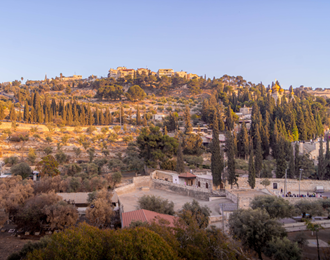Golgotha on the Mount of Olives?
08-08-2025 - Posted by Geert-JanOriginally posted on August 5, 2025 – by Andre Piet
Where was the cross located on which Jesus died? The traditional location west of Jerusalem — near the Church of the Holy Sepulchre or the so-called “Gordon’s Calvary” — has little Biblical foundation. By contrast, there is compelling evidence that Golgotha was situated on the eastern side of the city, on the Mount of Olives.
To begin with: the Gospels never speak of a hill called Golgotha. The name simply means “place of a skull” — a designation of the nature or shape of the place, not of an elevation. Yet “the hill of Golgotha” often appears in songs and tradition, without any Scriptural basis. Such expressions easily obscure what the Bible actually says.
View of the temple curtain
A powerful clue is found in Matthew 27:50–54. At the moment Jesus gives up the spirit, the curtain of the temple is torn in two from above to below. And the Roman centurion saw this happen — a detail often overlooked. He saw the earthquake and “what is occurring,” and exclaimed: “Truly, this was a Son of God!”
But from where could one see the curtain of the temple? Only from the Mount of Olives could one have a view of the entrance to the temple and the massive curtain hanging in front of the holy place. According to Flavius Josephus, this curtain was 80 feet high and 24 feet wide — still clearly visible even from a kilometer away. The centurion was thus standing on the east side of Jerusalem. That is where Golgotha must have been located.
“Near the place”
John 19:20 provides another clue: “The place of the city where Jesus was crucified was near.” In Greek, it literally reads: “Near was the place of the city where He was crucified.” That expression “the place” (ho topos) is known as a designation for the temple (cf. John 4:20; 11:48; Acts 6:13–14). Jesus was thus crucified outside the city, but in direct proximity to the temple — exactly what applies to the Mount of Olives.
Outside the camp
The letter to the Hebrews states that Jesus “suffered outside the gate” (Hebrews 13:12), in accordance with the law of the sin offering which had to be burned outside the camp (Leviticus 16:27). But where was “outside the camp” in the days of the temple? The Mishna Middot (2:4) describes how the priest who slaughtered the red heifer stood on the Mount of Olives, with a direct view of the temple gate. According to rabbinic tradition, the ritual of the red heifer — also a type of cleansing from sin — took place on the east side of Jerusalem, outside the camp. “Outside the camp” meant: on the Mount of Olives.
The empty tomb
If Golgotha was located on the Mount of Olives, then Jesus’ tomb must also have been there. For John 19:41 states that the tomb was “at the place where He was crucified.” This connects the cross, the tomb, the resurrection, the ascension, and the return — geographically — to one mountain: the Mount of Olives. There He was lifted up, there He rose, there He will return — see Acts 1:12 and Zechariah 14:4.
Not for nothing a “mount of olives”
The Mount of Olives is not just a backdrop. The olive tree in Scripture represents life that is stronger than death. Think of the dove that returned to Noah with an olive branch — the first sign of life after judgment (Genesis 8:11). And think of the oil in the temple, which kept the light burning — a picture of the life that shines in the heavens.
The Mount of Olives is no footnote in the gospel, but the solid ground on which the great facts of salvation are anchored.

 English Blog
English Blog